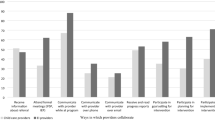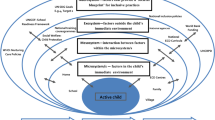Abstract
Infants, toddlers, and two-year-olds with disabilities or developmental delays often participate in center-based childcare. Just like other care and education settings, childcare for very young children should provide high-quality inclusion. To date, minimal research has been conducted on practitioner perspectives about inclusion in childcare for very young children, and no study has explored childcare practitioners’ use of inclusive practices to include very young children with disabilities. The purpose of this study was to explore childcare practitioners’ perceptions of their role and practices used to facilitate inclusion. We used a qualitative approach, interviewing childcare practitioners in one Midwest community about their experiences with inclusion. We found that childcare practitioners in this study perceived that inclusion involves close proximity of children with and without disabilities, teachers using individualized practices, and collaboration between adults (e.g., families, colleagues, administration). Some participants stated equity was important for inclusion, while others emphasized the need for equality. Participants also believed inclusive practices should support children’s identities, such as by teaching children about disability or culture. These views generally align with the tenets of early childhood inclusion (access, participation, supports). Implications include the need to support childcare practitioners in developing shared views of inclusion that supports all children in their work.

Similar content being viewed by others
Notes
There has been much debate over the past decades on the most respectful way to refer to individuals with disabilities (National Disability Rights Network, 2020). Whereas person-first terminology (e.g., child with autism) over identity-first terminology (e.g., autistic child) was once widely preferred, some individuals and institutions have recently opposed strict adherence to person-first terminology (Andrews et al., 2019). The American Psychological Association supports authors using a mix of person-first and identity-first terminology (APA, 2020). With these viewpoints in mind, we intentionally use both terms and retain language used in cited studies when possible.
References
Ammanna, S. A., Connor, D., & Ferri, B. (2013). Dis/ability critical race studies (DisCrit): Theorizing at the intersection of race and dis/ability. Race Ethnicity and Education, 16(1), 1–31. https://doi.org/10.1080/13613324.2012.730511.
American Psychological Association. (2020). Publication manual of the American Psychological Association (7th ed.). https://doi.org/10.1037/0000165-000.
Americans with Disabilities Act of (1990). 42 U.S.C. 1201 et seq (1990). https://www.ada.gov/pubs/adastatute08.htm.
Andrews, E. E., Forber-Pratt, A. J., Mona, L. R., Lund, E. M., Pilarski, C. R., & Balter, R. (2019). #SaytheWord: A disability culture commentary on the erasure of disability. Rehabilitation Psychology, 64(2), 111–118. https://doi.org/10.1037/rep0000258.
Barton, E. E., & Joseph, J. D. (2015). What is quality inclusion? In E. E. Barton, B. J. Smith, & C. L. Salisbury (Eds.), The Preschool Inclusion Toolbox: How to Build and Lead a High-Quality Program (pp. 33–44). Brookes.
Beneke, M. R., Newton, J. R., Vinh, M., Blanchard, S. B., & Kemp, P. (2019). Practicing inclusion, doing justice: Disability, identity, and belonging in early childhood. Zero to Three, 39(3), 26–34.
Birk, M., Chapman, Y., & Francis, K. (2008). Memoing in qualitative research: Probing data and processes. Journal of Research in Nursing, 13(1), 68–75. https://doi.org/10.1177/1744987107081254.
Brantlinger, E., Jimenez, R., Klinger, J., Pugach, M., & Richardson, V. (2005). Qualitative studies in special education. Exceptional Children, 71(2), 195–207. https://doi.org/10.1177/001440290507100205.
Braun, V., & Clarke, V. (2006). Using thematic analysis in psychology. Qualitative Research in Psychology, 3(2), 77–101. https://doi.org/10.1191/1478088706qp063oa
Buysse, V., Wesley, P., Keyes, L., & Bailey, D. B. Jr. (1996). Assessing the comfort zone of child care teachers in serving young children with disabilities. Journal of Early Intervention, 20(3), 189–203. https://doi.org/10.1177/105381519602000301.
California Department of Education. (2021). Inclusion works! Creating child care programs that promote belonging for children with disabilities (2nd ed.). Sacramento. https://www.cde.ca.gov/sp/cd/re/documents/inclusionworks2ed.pdf.
CAST. (2024). About Universal Design for Learning. https://www.cast.org/impact/universal-design-for-learning-udl.
Ceglowski, D. A., Logue, M. E., Ullrich, A., & Gilbert, J. (2009). Parents perceptions of child care for children with disabilities. Early Childhood Education Journal, 36(6), 497–504. https://doi.org/10.1007/s10643-009-0309-0.
Coleman, H., Hestenes, L., & Ozdemir, M. K. (2022). Quality in inclusive and non-inclusive infant and toddler classrooms: What are the trends after 15 years? Journal of Research in Childhood Education, 36(1), 126–142. https://doi.org/10.1080/02568543.2021.1880995.
Costanzo, M. A., & Magnuson, K. (2019). How does disability influence child care arrangements for young children? An examination using the NHES ECPP. Children and Youth Services Review, 99, 210–225. https://doi.org/10.1016/j.childyouth.2019.02.019.
Derman-Sparks, L., Edwards, J. O., & Goins, C. M. (2020). Anti-bias education for young children and ourselves (2nd ed.). NAEYC.
Dinnebeil, L. A., McInemey, W., Fox, C., & Juchartz-Pendry, K. (1998). An analysis of the perceptions and characteristics of childcare personnel regarding inclusion of young children with special needs in community-based programs. Topics in Early Childhood Special Education, 18(2), 118–128. https://doi.org/10.1177/027112149801800207.
Division for Early Childhood. (2014). DEC recommended practices in early intervention/early childhood special education 2014. http://www.decsped.org/recommendedpractices.
DEC/NAEYC (2009). Early childhood inclusion: A joint position statement of the Division for Early Childhood (DEC) and the National Association for the Education of Young Children (NAEYC). Chapel Hill: The University of North Carolina, FPG Child Development Institute. https://www.naeyc.org/sites/default/files/globally-shared/downloads/PDFs/resources/position-statements/ps_inclusion_dec_naeyc_ec.pdf.
Green, K. B., Terry, N. P., & Gallagher, P. A. (2014). Progress in language and literacy skills among children with disabilities in inclusive early reading first classrooms. Topics in Early Childhood Special Education, 33(4), 249–259. https://doi.org/10.1177/0271121413477498.
Guralnick, M. J., & Bruder, M. B. (2016). Early childhood inclusion in the United States: Goals, current status, and future directions. Infants & Young Children, 29(3), 166–177. https://doi.org/10.1097/IYC.0000000000000071.
Hestenes, L. L., Cassidy, D. J., Shim, J., & Hegde, A. V. (2008). Quality in inclusive preschool classrooms. Early Education and Development, 19(4), 519–540. https://doi.org/10.1080/10409280802230973.
Individuals With Disabilities Education Improvement Act (2004). 20 U S C § 1400.
Koliouli, F., Pinel-Jacquemin, S., & Gaudron, C. Z. (2022). Perceived barriers and facilitators in infant-toddler daycare inclusion: The childcare professionals’ point of view. International Journal of Early Childhood, 54(2), 165–184. https://doi.org/10.1007/s13158-021-00309-4.
Lareau, A. (2021). Listening to people: A practical guide to interviewing, participant observation, data analysis, and writing it all up. The University of Chicago.
Love, H., & Beneke, M. (2021). Pursuing justice-driven inclusive educational research: Disability critical race theory (DisCrit) in early childhood. Topics in Early Childhood Special Education, 41(1), 31–44. https://doi.org/10.1177/0271121421990833.
Love, H., & Horn, E. (2021). Definition, context, quality: Current issues in research examining high-quality inclusive education. Topics in Early Childhood Special Education, 40(2), 204–216.
Mohay, H., & Reid, E. (2006). The inclusion of children with a disability in child care: The influence of experience, training and attitudes of childcare staff. Australian Journal of Early Childhood, 31(1), 35–42. https://doi.org/10.1177/183693910603100106.
Muccio, L. S., Kidd, J. K., White, C. S., & Burns, M. S. (2014). Head Start instructional professionals’ inclusion perceptions and practices. Topics in Early Childhood Special Education, 34(1), 40–48. https://doi.org/10.1177/0271121413502398.
NAEYC. (2022). Developmentally appropriate practice in early childhood programs serving children from birth through age 8 (4th ed.). NAEYC.
National Center for Educational Statistics [NCES] at Institute of Education Sciences [IES]. (2021). Early Childhood Program participation: 2019. U.S. Department of Education.
National Disability Rights Network. (2020, September 8). Communicating about people with disabilities. https://www.ndrn.org/resource/communicating-about-people-with-disabilities/.
Novoa, C. (2020). The child care crisis disproportionately affects children with disabilities. Center for American Progress.
Odom, S. L., Buysse, V., & Soukakou, E. (2011). Inclusion for young children with disabilities: A quarter-century of research perspectives. Journal of Early Intervention, 33(4), 344–356. https://doi.org/10.1177/1053815111430094.
Ortega, P., Shin, T. M., & Martínez, G. A. (2022). Rethinking the term limited English profiency to improve language-appropriate healthcare for all. Journal of Immigrant and Minority Health, 24, 799–805. https://doi.org/10.1007/s10903-021-01257-w.
Paschall, K., Madill, R., & Halle, T. (2020). Professional characteristics of the early care and education workforce: Descriptions by race, ethnicity, languages spoken, and nativity status. OPRE Report #2020 – 107. Office of Planning, Research, and Evaluation, Administration for Children and Families, U.S. Department of Health and Human Services.
QR Collective, The. (2023). Reflexive qualitative criteria: Questions and indicators for purpose-driven special education qualitative research. Exceptional Children, 89(4), 449–466. https://doi.org/10.1177/00144029231168106.
Rafferty, Y., & Griffin, K. W. (2005). Benefits and risks of reverse inclusion for preschoolers with and without disabilities: Perspectives of parents and providers. Journal of Early Intervention, 27(3), 173–192. https://doi.org/10.1177/105381510502700305.
Saldaña, J. (2021). The coding manual for qualitative researchers (4th ed.). SAGE.
Saunders, B., Sim, J., Kingstone, T., Baker, S., Waterfield, J., Bartlam, B., Burroughs, H., & Jinks, C. (2018). Saturation in qualitative research: Exploring its conceptualization and operationalization. Quality & Quantity, 52(4), 1893–1907. https://doi.org/10.1007/s11135-017-0574-8.
Schaub, S., & Lütolf, M. (2023). Attitudes and self-efficacy of early childhood educators towards the inclusion of children with disability in day-care. European Journal of Special Needs Education. https://doi.org/10.1080/08856257.2023.2200106
Sheppard, M. E., & Moran, K. K. (2021). The role of early care providers in early intervention and early childhood special education systems. Early Childhood Education Journal, 50(6), 891–901. https://doi.org/10.1007/s10643-021-01225-x.
Stahmer, A. C., & Carter, C. (2005). An empirical examination of toddler development in inclusive childcare. Early Child Development and Care, 175(4), 321–333. https://doi.org/10.1080/0300443042000266231.
Stahmer, A. C., Carter, C., Baker-Ericzen, M., & Miwa, K. (2003). Parent perspectives on their toddlers’ development: Comparison of regular and inclusive childcare. Early Child Development and Care, 173(5), 477–488. https://doi.org/10.1080/0300443032000088267.
Steed, E. A., Rausch, A., Strain, P. S., Bold, E., & Leech, N. (2021). High-quality inclusion in preschool settings: A survey of early childhood personnel. Topics in Early Childhood Special Education, 43(2), 142–155. https://doi.org/10.1177/02711214211063921.
Steed, E. A., Strain, P. S., Rausch, A., Hodges, A., & Bold, E. (2023). Early childhood administrator perspectives about preschool inclusion: A Qualitative interview study. Early Childhood Education Journal. https://doi.org/10.1007/s10643-023-01448-0
Strain, P. S., & Bovey, E. H. (2011). Randomized, controlled trial of the LEAP model of early intervention for young children with autism spectrum disorders. Topics in Early Childhood Special Education, 31(3), 133–154. https://doi.org/10.1177/0271121411408740.
Tracy, S. J. (2010). Qualitative quality: Eight big-tent criteria for excellent qualitative research. Qualitative Inquiry, 16(10), 837–851. https://doi.org/10.1177/1077800410383121.
U.S. Department of Human Services & U. S. Department of Education. (2015). Policy statement on inclusion of children with disabilities in early childhood programs.
Weglarz-Ward, J. M., & Santos, R. M. (2018). Parent and professional perceptions of inclusion in child care: A literature review. Infants & Young Children, 31(2), 128–143. https://doi.org/10.1097/IYC.0000000000000115.
Weglarz-Ward, J. M., Santos, R. M., & Timmer, J. (2019). Factors that support and hinder including infants and toddlers with disabilities in child care. Early Childhood Education Journal, 47(2), 163–173. https://doi.org/10.1007/s10643-018-0900-3.
Weglarz-Ward, J. M., Santos, R. M., & Hayslip, L. A. (2020). How professionals collaborate to support infants and toddlers with disabilities in child care. Early Childhood Education Journal, 48(5), 643–655. https://doi.org/10.1007/s10643-020-01029-5.
Wertlieb, D. (2018). Inclusive early childhood development: Ensuring the rights and well-being of infants and toddlers with disabilities and their families. Zero to Three, 38(4), 22–30.
Wiart, L., Kehler, H., Rempel, G., & Tough, S. (2013). Current state of inclusion of children with special needs in child care programmes in one Canadian province. International Journal of Inclusive Education, 18(4), 345–358. https://doi.org/10.1080/13603116.2013.767386.
Wiegand, S. D., Citta, C., Vail, C. O., Lieberman-Betz, R. G., & Brown, J. A. (2022). Recommendations to promote high-quality inclusion for infants and toddlers with disabilities. Zero to Three, 42, 1–6.
Wong, S., & Cumming, T. (2010). Family day care is for normal kids: Facilitators and barriers to the inclusion of children with disabilities in family day care. Australasian Journal of Early Childhood, 35(3), 4–12. https://doi.org/10.1177/183693911003500302.
Funding
This work was supported in part by U.S. Department of Education, Office of Special Education Programs: Project TI3: Trauma-Informed Early Intervention, Early Childhood Special Education, and Social Work (Grant number H325K180123).
Author information
Authors and Affiliations
Corresponding author
Additional information
Publisher’s Note
Springer Nature remains neutral with regard to jurisdictional claims in published maps and institutional affiliations.
Supplementary Information
Below is the link to the electronic supplementary material.
Rights and permissions
Springer Nature or its licensor (e.g. a society or other partner) holds exclusive rights to this article under a publishing agreement with the author(s) or other rightsholder(s); author self-archiving of the accepted manuscript version of this article is solely governed by the terms of such publishing agreement and applicable law.
About this article
Cite this article
Sawyer, G.E., Sheikh, M.Y. & Hardy, J.K. Inclusion of Infants and Toddlers: Perspectives from Childcare Providers. Early Childhood Educ J (2024). https://doi.org/10.1007/s10643-024-01640-w
Accepted:
Published:
DOI: https://doi.org/10.1007/s10643-024-01640-w




